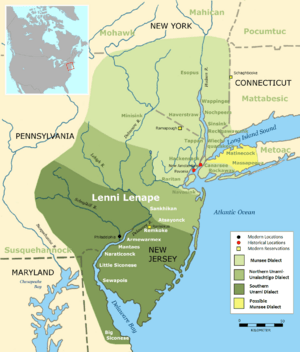Hackensack people facts for kids
Hackensack was the name given by Dutch settlers to a group of Lenape people. The Lenape called themselves Lenni-Lenape, which means "original men." This Native American tribe lived in what is now northeastern New Jersey, near the Hudson River and Hackensack River. Europeans often named small groups of native people after the places where they lived.
Their Land and Way of Life
The Hackensack people lived in an area they called Ack-kinkas-hacky, which meant "place of stony ground" or "mouth of a river." This land included areas around Upper New York Bay, Newark Bay, the New Jersey Meadowlands, and the Palisades.
The Hackensack were part of the larger Lenape family. They spoke the Unami dialect, which was one of the main Lenape languages. Unami meant "people down river." These languages were part of the Algonquian language family.
Other groups who spoke Unami in the area included the Raritan near Staten Island, the Acquackanonk along the Passaic River, and the Tappan near the Palisades. These groups, along with others, were sometimes called the River Indians.
The Lenape people grew crops like corn, beans, and squash. They also gathered wild plants, hunted animals, fished, and trapped. They moved their villages every few years to let the land recover. Their main summer camp was at Gamoenpa, which meant "the big landing-place." At Hopoghan Hackingh, they found special stone to carve tobacco pipes.
The Hackensack people identified with the totem of the turtle. The "Turtle Clan" was highly respected among the Lenape, especially for their role in making peace. Their society was based on everyone agreeing on decisions. A sachem, or chief, was important but had to follow the decisions made by the tribal council.
In the 1600s, there were about one thousand Hackensack people, with 300 warriors. A very important chief at that time was Oratam, who was born around 1576. He was likely also the chief of the Tappan, a related group. Some believe the Tappan and Hackensack were one tribe because the same chiefs signed land deals for both.
Dutch Settlers and New Jersey
After Henry Hudson explored the area in 1609, the Dutch claimed Hackensack lands as part of their colony, New Netherland. The Hackensack lived close to the capital, New Amsterdam, which is now Manhattan. This meant they had a lot of contact with the Dutch settlers.
They traded beaver furs and sewant (shell beads) for European goods like tools and firearms. The Hackensack also sold land to the Dutch, which became places like Pavonia, Hoboken, and Weehawken.
In 1658, Peter Stuyvesant, the leader of New Netherland, bought a large area of land from the Hackensack. This land became known as Bergen. In 1666, the Hackensack sold the land that would become the city of Newark.
In 1669, Chief Oratam gave a large piece of land to Sara Kiersted, a woman who knew the Lenape language and helped as an interpreter. Oratam also helped make many land deals and peace agreements between the native people and the settlers. He helped end wars like Kieft's War and the Esopus Wars.
A writer named David Pietersz. de Vries wrote about his observations of the Hackensack people in 1655.
The British took control of New Netherland between 1663 and 1674, around the time Chief Oratam passed away. The new British government quickly claimed and sold lands throughout Hackensack territory. In most cases, the Lenape were paid for their land.
Challenges During European Settlement
In 1600, there might have been as many as 20,000 Lenape people. However, several wars and at least 14 different diseases brought by Europeans, like smallpox and influenza, greatly reduced their population. By 1700, there were only about 4,000 Lenape left. Native Americans had no natural protection against these European diseases, which had been common in Europe for centuries. This caused many deaths.
As the Lenape population decreased and the European population grew, the history of the area became more about the new European settlers. The Lenape tribes played a smaller role.
By the mid-1700s, the English colonists generally called the Lenape people the Delaware. This was because their main territory was along the Delaware River and its bay, which were named after a British governor. Some Lenape groups moved west to avoid the growing European settlements.
In the 1700s, the Lenape signed agreements like the Walking Purchase in Pennsylvania and the Treaty of Easton. The British wanted to control lands they had gained after the French and Indian War. The Native Americans tried to stop more Europeans from moving onto their lands. Today, Lenape groups live in different parts of the United States.



